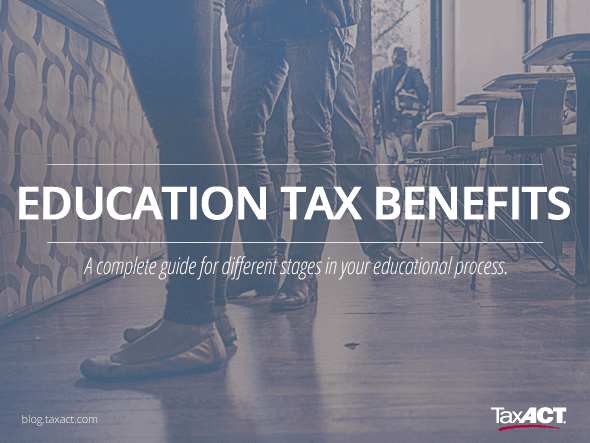
With so many plans for tax benefits, credits and deductions the tax benefits of education can seem complicated.
Where do you start?
If the number of available tax benefits of education is any indication, the government has taken an interest in the promotion of higher education and make it easier for more people to reach.
sort all the different benefits can be confusing, but it is easier to look through time.
Here are the tax benefits of education, you can usually enjoy at different points in your educational process:

Before college: save, save, save
You'll want to start well in advance to make these plans tax benefits worth
Choose from basic education savings Plans :.
qualified tuition program (529 Plan)
With a 529 plan, you make non-deductible contributions to an account. When it's time to pay for college, you take tax-free withdrawals to pay for tuition and fees.
If you use the prepaid plan, you use tax-free education loans.
A 529 Plan is in your name, not the child. Depending on your state, you may be able to further contribute to a 529 plan than is permitted by other programs.
Unlike other programs, the 529 plan does not depend on your income.
If you make a lot more money when it comes time for college, the plan is not limited depending on your income level.
education program savings bonds
you can buy EE bonds issued after US savings series 1989 or series of bonds I. You buy them in your name.
When it's time for college, you cash bonds. You do not pay tax on interest obligations insofar as the expenditure comply with qualifications.
Be careful if your income may be higher when you want to use the links.
This tax benefit begins to phase out when you reach a level adjusted gross adjusted income of $ 76,000 ($ 113,950 if married filing jointly on).
account Coverdell Education Savings (ESA)
These plans are made to the student's name, not the parent or benefactor. You (and other contributors) can contribute up to a combined total of $ 2,000 per year on behalf of the student.
You do not get a deduction for your contribution, but when the child goes to college, he or she can make tax-free withdrawals from the original contribution plus interest or other earnings
you can also choose to take distributions from ESAs for primary and secondary education
during the University: .. take credits and deductions
When you go college or send someone out there, every little helps tax benefit.
American Opportunity Tax Credit (formerly Hope credit)
it is more than a little tax advantage.
This credit pays for 100% up to the first tranche of $ 00 you spend on tuition, fees, books, supplies and equipment.
you may also be eligible for 25% of the next $ 2,000 in credit - .. for a total credit of up to $ 2,500
credit may be for you, your spouse or your dependents
the student must be enrolled at least half time and be in the first four years of college. You might not be eligible for this credit if you have a higher income.
This credit begins to eliminate if your modified adjusted gross income is more than $ 80,000 ($ 0,000 if filing jointly).
You can not take the credit if your modified adjusted gross income is more than $ 0,000 ($ 180,000 if filing jointly).
Lifetime Learning Credit
the best thing the American Opportunity tax credit is the Lifetime Learning Credit.
It gives you a credit equal to 20% of your tuition and certain related expenses up to $ 10,000. This is a credit up to $ 2,000 per student.
This credit begins to eliminate if your modified adjusted gross income is more than $ 54,000 ($ 108,000 if filing jointly).
You can not take the credit if your modified adjusted gross income is more than $ 64,000 ($ 128,000 if filing jointly).
Note that you can not claim the American Opportunity Credit and the Lifetime Learning Credit for the same student in the same year.
the deduction higher education spending
This deduction expired at the end of 2013 not to throw those receipts away yet, however.
Congress has the habit of extending provisions like this at the last minute.
this deduction in the past has left to reduce your taxable income by as much as $ 4,000, even if you itemize your deductions.
After college: Deduct student loan interest
you have saved for college, you took advantage of the tax benefits while going to college, but he still had to take student loans to meet the finish line
A. least the IRS is offering another educational tax advantage for you.
If you pay interest on student loans, you may be able to deduct interest as an adjustment to income, regardless of whether you itemize your deductions.
you can deduct student loan interest for as long it takes you to pay it back.
If you have a huge amount of student loan debt, you may not be able to deduct all the interest.
This deduction is limited to $ 2 500 in student loan interest.
If your modified adjusted gross income is $ 65,000 or more ($ 130,000 if filing jointly), the maximum deduction begins to fall out.
you can not take this deduction if you are married and filing separately.

0 Komentar